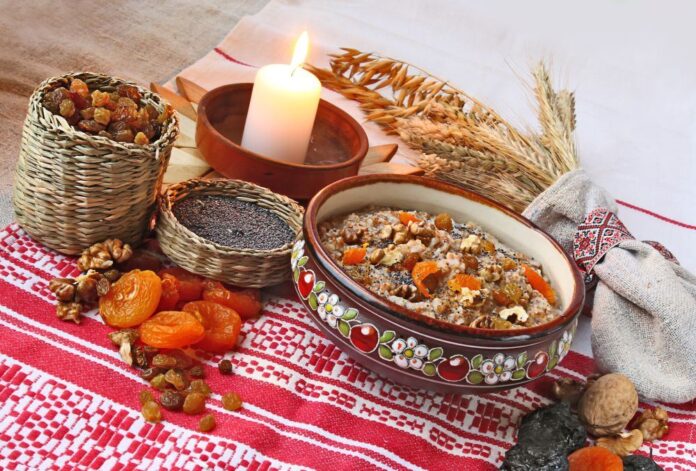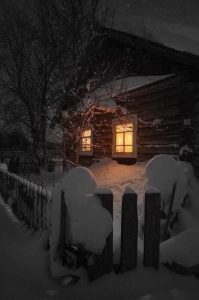
Even though your Lithuanian may be rusty, you probably remember the word for the traditional Christmas Eve dinner at your parents‘ or grandparents‘ home: Kūčios (koo-chose).
The word is derived from kūčia (koo-cha), which was a mixture of beans, grains and honey that was the only food eaten on Christmas Eve. It is said that the word comes from the Greek kukkia, meaning beans, and was mentioned in the first Lithuanian literature in 1573. Also the words khutschi and kuhki in a Latvian dictionary dated 1789 mean peas and wheat cooked together.The first spoonfuls of the kūčia were offered to the souls of the dead and the harvest gods, and were eaten with the poppy seed milk. This, as a substitute for cow‘s milk, is still made in many households on Christmas Eve and eaten with the cranberry pudding and poppy seed biscuits. (Read more about food in the section “What are you making for Kūčios?“)
Some of us may remember going home or to friends‘ homes to eat goose after midnight Mass, and not turkey on Christmas Day.
The Kūčios meal is a family occasion which used to include many traditions of both pagan and Christian origin. Some traditions are no longer widespread and usually Lithuanians just enjoy dinner with relatives and friends while the main events and festivities are left for Christmas Day.
Everyone in the family would make a special effort to come home for the Christmas Eve supper. The purpose was to bring family members together and strengthening family ties. In this spirit, if a family member died that year, an empty place was left at the table. A small candle placed on the plate and lit during the meal meant that the spirit of the deceased family member was participating. In the past, Kūčios was a serious and prayerful occasion in preparation for the birth of Christ.
Preparing for Kūčios was an all day event. On Christmas Eve, the entire house would be thoroughly cleaned and bed linens changed. Everyone attending would bathe and dress in clean clothes before the evening meal. Disputes with neighbours must be resolved, enemies forgiven and debts paid before gathering at the table.
Traditionally, people fasted and abstained from meat for the entire day. Many Lithuanians still adhere to the original custom of abstinence.
 For the Christmas Eve dinner, the table was prepared in a special way. A handful hay was spread under a white tablecloth as a reminder that Jesus was born in a stable and lay in a manger. The table was decorated with symbols of the life force such as fir boughs, candles, and a bundle of unthreshed rye, which pagan families would traditionally bind around their apple trees the next day. Live flowers were not normally used.
For the Christmas Eve dinner, the table was prepared in a special way. A handful hay was spread under a white tablecloth as a reminder that Jesus was born in a stable and lay in a manger. The table was decorated with symbols of the life force such as fir boughs, candles, and a bundle of unthreshed rye, which pagan families would traditionally bind around their apple trees the next day. Live flowers were not normally used.
In the olden days, dinner started when the first star appeared in the sky. Waiting for the star to appear in the sky symbolized the Star of Bethlehem leading shepherds to Bethlehem.
In certain Lithuanian regions apples were placed on the table because December 24 is the feast day of Adam and Eve.
In the past, rituals used to be widespread, but are not as common today. Most were meant to predict the future and welfare of family members:
• A stalk of hay would be pulled randomly from under the tablecloth: the person drawing the longest straw will live the longest life, while the person with the thickest straw will have the most fulfilling life. A bent straw indicates the holder will have a turn in their life, while a forked straw indicates many decisions to come in the following year. If a long, slender stalk is withdrawn, a girl can expect a tall slender husband, while a short, fat, bent stalk means a short, fat crooked husband. The same applies to young unmarried men drawing straws. Married persons can also guess next year’s happiness from the kind of stalk pulled. A thin stem indicates a flat, empty wallet, while a thick one means a prosperous year, a full wallet. If a married woman pulls a straw thicker in the middle, she will have a baby that year.
• While seated at the table and looking at the walls where candlelight casts the shadows of those dining, if the shadow is large, wide and of the whole person, the year will be good, there will be no illness. If the shadow lacks a head a terrible calamity will occur; if it is skinny, unclear and wavering, the year will be difficult.
After the meal, everyone would leave the table to go to sleep or to midnight Mass, known as the Shepherds’ Mass. The food was left on the table overnight. It was believed that the spirits of deceased relatives or loved ones would visit the home during the night and the table set with food would make them feel welcome. It was believed that the newborn Jesus allowed the souls of all the departed to return to earth to visit their families.
Many Kūčios traditions for either predicting the future or assuring success in the next year predate Lithuania’s adoption of Christianity and, as such, are pagan beliefs.
On Kūčios, as during many other Lithuanian feasts, much attention is paid to wedding themes. Many of these rituals involve the maidens in the house. There are several rare marriage charms:
• The windows are covered after the meal is completed, a rooster and hen are pulled out from under the stove, and their tails are tied together. If the rooster pulls the hen to the door, there will be a wedding and if he pulls the hen back under the stove, there will be no wedding.
• Three items are placed on the doorsill: a ring, a piece of chalk and a piece of bread. A hen is brought out. If the hen picks up the ring, the girl will marry. If the hen picks up the piece of chalk, the girl will die. The girl will live poorly if the hen picks up the bread.
• A pot of water is brought to a boil and then two pieces of coal are dropped into the water. If the coals come together, there will be a wedding.
• Every girl in the room lights a candle. All the candles are placed on the table’s edge and blown out by the master of the house. The girl whose candle is not blown out will remain unmarried.
• A ring is dropped into a half-filled glass of water by a maiden. The number of ripples shows the number of years before her wedding.
• At midnight, girls place two sacred candles and between them a glass filled with water, birch ashes and a wedding band inside. Looking through the glass, they will either see their chosen male or a coffin.
• Three whole herring should be eaten by a maiden before going to bed. A towel should be placed on two wooden rods, set over a bowl filled with water by their bed. They will dream of their future husband while sleeping.
• A long cloth is tied into even knots containing money, a piece of coal, a lump of earth, a piece of clay from the stove, grain or seeds, and a small rag. All these knotted pieces are placed in a tub, next to the girl’s bed, so that they can be touched without leaving the bed. The ring represents a wedding, money – riches, coal – fire, earth – death, the rag – children, seeds or grains – represent a good harvest.
• Two needles are dropped into a plate filled with water. If the needles come together, there will be a wedding.
On Christmas Eve a greater attention was given to animals. This was to ensure their health and fertility:
• Hay from the supper table was later fed to the animals.
• To assure that animals do not scatter in the summer, the entire family must eat the Kūčios supper together.
• Those who sprinkle a mixture of wheat and peas in the barn will have healthy animals the following year.
The plenitude of rituals among Lithuanian country folk is indicative of how closely Lithuanians were tied to the land, and, of course, dependent on the success of their crops. Many are described in old Lithuanian literature, and more recently in the bilingual book Lithuanian Customs and Traditions by Danutė Bindokienė.
With information from Wikipedia and Lith. Customs and Traditions





























